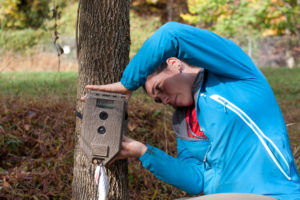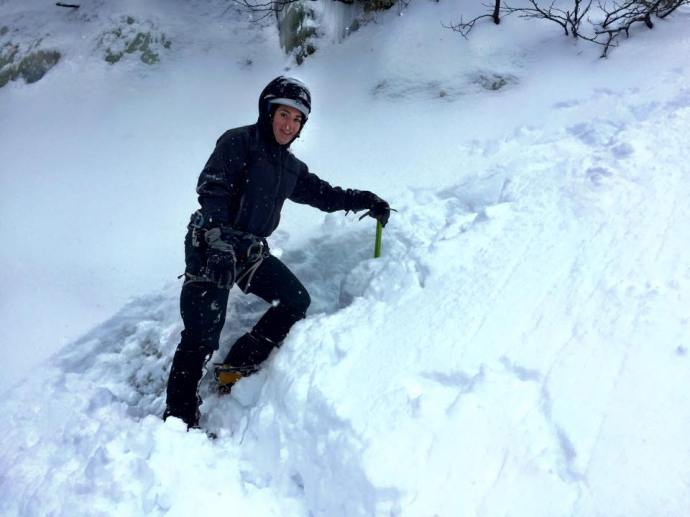https://wamu.org/story/17/12/07/city-dense-d-c-much-wildlife/

My first published piece! Thank you Misadventures magazine! This story is about my journey to East Africa and visiting Dian Fossey’s grave in Rwanda back in 2012.
With ongoing unrest in the Democratic Republic of Congo, Rwanda remains one of only two countries where the critically endangered Mountain Gorillas can be safely viewed, along with Uganda. Each year, approximately 17,000 people travel to Volcano National Park to see these striking quadrupeds. Upon visiting the area, fewer people extend the trip and make the half-day journey to the relics of the Karisoke grounds, visiting the final resting place of the iconic woman who studied these extraordinary animals.
Ten-plus years as a student and wildlife biologist have thickened my skin, as the field parallels that of Fossey’s day. The profession remains largely male-oriented; often times it feels like an uphill battle trying to win opportunities and be taken seriously. Because of this, Dian Fossey has been an exceptional role model for me: a woman whose struggles and triumphs I turn to whenever hardships surface on the job. With no formal training, she persuaded Louis Leakey to allow her to study the gorillas. He believed women stood decidedly more patient – a skill vital for such ongoing research projects, and a proficiency so brilliantly demonstrated by her chimpanzee-research colleague, Jane Goodall.
The big 3-0 arrived for me in 2012 and East Africa was my ultimate destination that year. The entire trip centered around visiting Fossey’s grave. I had a full month of holiday devoted to all the classics. But my final two days in Africa brought it all home: hikes to view the Mountain Gorillas and visit Fossey’s grave.
A rotund Ugandan man picked me up from my lodging at a Catholic monastery, delivering stories though a dense accent I could hardly understand, though I couldn’t help but smile at his animation and excitement. After 20 minutes, he dropped me off in Volcano National Park, where I filed in with the hundreds who came to view Mountain Gorillas. Groups divided based on physical demands. I felt fighting-fit after summiting Kilimanjaro and opted for a more strenuous walk: two hours weaving up endless switchbacks, until we made it to the stone-wall entrance of the park. Our shirts heavy with sweat, we scrambled over the fence, trading hilly potato fields for a wall of greenery. The gorillas lingered nearby. My pace quickened with the exhilaration Fossey must have felt decades ago.
Suddenly, the renowned primates appeared almost out of nowhere. A mother and infant Mountain Gorilla materialized before my eyes. One by one, the complete Bwenge family appeared, including the male silverback. The time had come to stop being a tourist, put the camera away and enjoy my fleeting time with these amazing creatures.
That evening, my Ugandan driver joined me for dinner. Indulging in well-deserved Primus beers, we chatted as I nursed my nettle wounds and recovered from the vigorous four-hour hike up to 3,000 meters. Barely able to lift my beverage, I thanked him for the day’s workout and conveyed my anticipation for Fossey’s grave the following morning. Intriguingly, he shared thoughts similar to those I had read in National Geographic: the Rwandan government was probably not blameless in Fossey’s murder. He further educated me about the numerous former poachers who converted to gorilla trackers and guides for the tourism industry.
The following morning, he came to collect only me. Hundreds of anxious gorilla viewers loitered at the visitor center, but today, how many of us would go pay homage to the woman who made it all possible? In about an hour’s time, my leader emerged. As I scanned behind me, the multitudes had disappeared and only a French lady remained, clutching a basket of hideous funeral-styled flowers. This was it: “the group.”
The path resembled yesterday’s, but today my locomotive huffing and puffing stayed far from my mind. Recalling the film Gorillas in the Mist, I envisioned Fossey’s initial walk to this camp. The jungle loomed as equally colossal now as then. How long did it take her to get back to civilization? Might these be her same tracks? Maybe these deliberations mimicked ones my French companion entertained, though we could not express them to each other.
Remnants of structures comprised camp boundaries: the kitchen, the volleyball court, Fossey’s original cabin. Spiraling through, we reached a dwarfed wooden fence filled with tiny grave markers and a large one. “Nyiramachabelli.” Translated: “the lone woman of the forest.” The Rwandan name she acknowledged and the name she took with her to the grave, inscribed on the headstone above her English one.
The plot beside Fossey belonged to none other than the infamous male gorilla, Digit. For the first time during the entire hike, the French lady and I connected. We stood side-by-side: two lone women who hiked to pay tribute to this remarkable woman. Tears filled our eyes and we each sank down on one knee in respect.
Silence dominated the return to the visitor center, but my thoughts churned boundlessly. I became more inspired than ever. Fossey’s energy surged through me. Perhaps one day my work with wildlife would be recalled as fondly as hers. Regardless, I felt recharged and prepared to work hard because in her own immortal words: “when you realize the value of all life, you dwell less on what is past and concentrate more on the preservation of the future.”

May 9, 2016. The summit of Mount Washington in New Hampshire received 2.8″ of snowfall winds gusting at 103 mph today. Winter had returned. Those conditions rang familiar with my first attempt at the Mount Washington summit.
My feelings towards Mount Washington are mixed, to say the least. The first trip there was after months of training hikes to prepare of the strenuous conditions (you may recall a previous blog) in January 2015. I was fit, equipped with crampons, axes, and loaded with a weekend worth of food in my 60 liter pack.
The hike to Harvard Cabin was a pure slice of hell. While less than 3 miles, the sustained uphill climb in over 2 feet of snow led to immediate shedding of clothing layers, profuse sweating, and a lot of swearing. Why the hell did I pack so much s%&t!
Reaching the cabin after what felt like days, my sites were on dry clothes, food, and my sleeping bag that resided somewhere in the deep depths of my pack. Our party was full of characters (a topic for another time), all in good alpine spirits.We were ready for 2 days of skill learning.
Saturday played in our favor. A continuous dumping of fresh powder made for a delightful alpine playground perfect for practicing walking in crampons, steps, and self arrest. The only thing was the avalanche danger was high. This meant limited options of where we could travel and only one trail was open to the summit.
Waking up Sunday morning to the hear the ranger call in the forecast to the cabin, I grumbled and burrowed deeper into my sleeping bag. More snowfall overnight and current summit conditions indicated winds over 70 mph. But, it was clear. So, out of the sleeping bag I squirmed.
With spring in my step, crampons on my feet, ice ax in my hand I made my way to the front of the group up the Tuckerman Ravine trail. The ascent got steeper and a bit more climbing and skill was required. As we neared the end of the treeline, we prepped ourselves with wind resistant gloves, shells, and goggles, as we knew the winds would be too strong for a costume change in the Alpine Garden and our eyeballs would freeze before we got there if googles were absent.
The events after reaching the Alpine Garden seemed to happen rapidly. Ethan and I had made our way behind one of the scant boulders and waited for the rest of our party. Where were they? We need to move. I’m getting cold. This is not good. We agreed to keep moving, but then delayed again. By the time the rest of the party reached us, the sides of my face were numb. Let’s move.
Step, step, plunge the ax in the ice and get down. The winds were nothing I had experienced before. Over 90 mph, I could barely walk. Every time I lifted a foot, I was blown off balance and feared I’d have to put those self-arrest skills to the test. Ugh, then a crampon released from one of my boots. What a time! I’m so cold. The sides of my face were so numb, I couldn’t be sure what was normal. “Have you have had frost nip?” Ethan asked. No I hadn’t, but if that was the risk, I had made it far enough. The risk was not worth it to me and although undeniably disappointed, I decided to descend. The summit would have to wait until another time.
That time came in January 2016 when I returned to Mount Washington as a mentor for the Alpine Skills weekend. Winter had just started to emerge, as I was there December for an avalanche course and there was barely a dusting of snow. Not ideal conditions for digging a snow pit, so the avalanche course would have to be completed at another time, buying yet another trip to Mount Washington.
The day before the January trip, I had started to become ill. But being an Aquarius and stubborn, I still made the journey up north for my mentor duties only to be informed by my men-tees that they really had no intention of doing the alpine skills or cie climbing. They were just there to hike. Seriously!?!?!?
Thinking I would change their minds, I loaded up the 60 liter pack once more and began the hellish slug to the Harvard Cabin. Only this time, I was assisting in hauling the club sled of gear up the path AND I was so congested, breathing was becoming an arduous task.
A familiar scene – muscles aching, sweat dripping, swearing galore, and this time, copious amounts of mucous hacked up – the Harvard Cabin came into view. A site for sore eyes! I would be staying in a tent this time. A tent that still needed to be pitched. In the dark.
After camp setup and dinner, I dragged my feverish butt into my -40 F degree sleeping bag for a night of wheezing, sweating, and shivering. Morning could not come soon enough.
But when it did, I awoke to meet my men-tees pulling the plug on the weekend. They were going back down. A lot of side conversations were had prior and after this decision, none of which will be mentioned. Why did I risk pneumonia to come up here! I too, made the decision to descend.
Once again, Mount Washington defeated me. My Everest.
The summit of Mount Washington in New Hampshire received 2.8″ of snowfall winds gusting at 103 mph today…
words and images, inspired by the most interesting time of the day
Applied conservation ecology research
Me. In the Wild
Me. In the Wild
Me. In the Wild
Exploring Destinations & Culture While Climbing